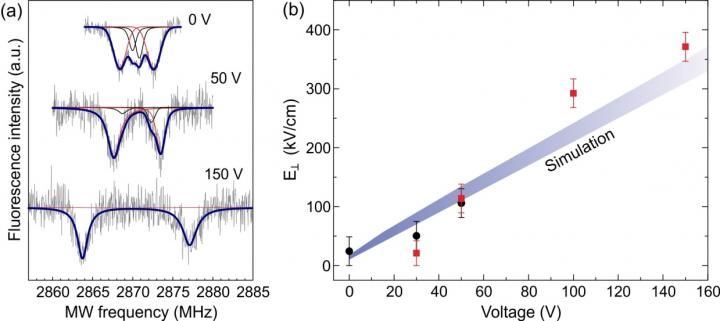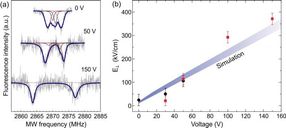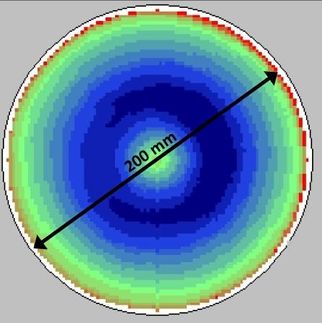Atomic-level sensors enable measurements of the electric field
Are artificially introduced into a working semiconductor device
semiconductors lie at the heart of many of the electronic devices that govern our daily lives. The proper functioning of semiconductor devices relies on their internally generated electric fields. Being able to measure these fields on the nanoscale is crucial for the development of next-generation electronics, but present techniques have been restricted to measurements of the electric field at a semiconductor's surface. A group of Takayuki Iwasaki, Mutsuko Hatano and colleagues at the Tokyo Institute of Technology, the Japan Science and Technology Agency (JST) and Toshiharu Makino at the National Institute of Advanced Industrial Science and Technology (AIST) has reported a new method for sensing internal electric fields at the interior of operating semiconductor devices. The technique exploits the response of an artificially introduced single electron spin to variations in its surrounding electric field, and enabled the researchers to study a semiconductor diode subject to bias voltages of up to 150 V.

Left: Schematic of the structure of the NV center. Middle: Confocal fluorescence image of a single NV center in the device. Right: Schematic of the measurement configuration.
Tokyo Institute of Technology

a: Optically detected magnetic resonance (ODMR) spectra of the NV center for various bias voltages V. b: The local electric field; experimentally and theoretically obtained values are in good agreement.
Tokyo Institute of Technology


Iwasaki and co-workers applied their method to diamond, a so-called wide-band-gap semiconductor in which the electric fields can become very strong -- a property important for low-loss electronic applications. Diamond has the advantage that it easily accommodates nitrogen-vacancy (NV) centers, a type of point defect that arises when two neighboring carbon atoms are removed from the diamond lattice and one of them is replaced by a nitrogen atom. NV centers can be routinely created in diamond by means of ion implantation. A nearby electric field affects an NV center's energy state, which in turn can be probed by a method called optically detected magnetic resonance (ODMR).
The researchers first fabricated a diamond p-i-n diode (an intrinsic diamond layer sandwiched between an electron- and a hole-doped layer) embedded with NV centers. They then localized an NV center in the bulk of the i-layer, several hundreds of nanometers away from the interface, and recorded its ODMR spectrum for increasing bias voltages. From these spectra, values for the electric field could be obtained using theoretical formulas. The experimental values were then compared with numerical results obtained with a device simulator and found to be in good agreement -- confirming the potential of NV centers as local electric-field sensors.
Iwasaki and colleagues explain that the experimentally determined value for the electric field around a given NV center is essentially the field's component perpendicular to the direction of the NV center -- aligned along one of four possible directions in the diamond lattice. They reason that a regular matrix of implanted NV centers should enable reconstructing the electric field with a spatial resolution of about 10 nm by combining with super-resolution techniques, which is promising for studying more complex devices in further studies.
The researchers also point out that electric-field sensing is not only relevant for electronic devices, but also for electrochemical applications: the efficiency of electrochemical reactions taking place between a semiconductor and a solution depends on the former's internal electric field. In addition, Iwasaki and co-workers note that their approach need not be restricted to NV centers in diamond: similar single-electron-spin structures exist in other semiconductors like e.g. silicon carbide.
Original publication
Other news from the department science
Most read news
More news from our other portals
See the theme worlds for related content
Topic world Sensor technology
Sensor technology has revolutionized the chemical industry by providing accurate, timely and reliable data across a wide range of processes. From monitoring critical parameters in production lines to early detection of potential malfunctions or hazards, sensors are the silent sentinels that ensure quality, efficiency and safety.

Topic world Sensor technology
Sensor technology has revolutionized the chemical industry by providing accurate, timely and reliable data across a wide range of processes. From monitoring critical parameters in production lines to early detection of potential malfunctions or hazards, sensors are the silent sentinels that ensure quality, efficiency and safety.





























































